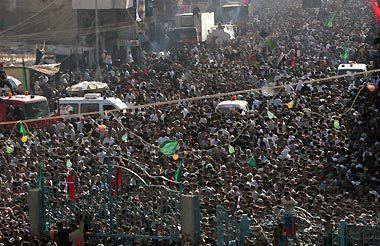Start date August 31, 2005 | ||
 | ||
Similar 1994 Gowari stampede, Burnden Park disaster, Luzhniki disaster, Ellis Park Stadium disaster, Accra Sports Stadium | ||
The 2005 Al-Aaimmah bridge stampede occurred on August 31, 2005 when 953 people died following a stampede on Al-Aaimmah bridge, which crosses the Tigris river in the Iraqi capital of Baghdad.
Contents
The stampede
At the time of the stampede, around one million pilgrims had gathered around or were marching toward the Al Kadhimiya Mosque, which is the shrine of the Imam Musa al-Kazim, one of the twelve Shi'a Imams. Tensions had been high within the crowd. Earlier in the day, seven people had been killed and dozens more wounded in a mortar attack upon the assembled crowd for which an Al-Qaeda linked insurgent group claimed responsibility. Near the shrine, rumors of an imminent suicide bomb attack broke out, panicking many pilgrims. Interior Minister Bayan Baqir Solagh said that one person "pointed a finger at another person saying that he was carrying explosives...and that led to the panic".
The panicked crowd flocked to the bridge, which had been closed. Somehow, the gate at their end of the bridge opened, and the pilgrims rushed through. Some people fell onto the concrete base and died instantly. The ensuing crush of people caused many to suffocate. The pressure of the crowd caused the bridge's iron railings to give way, dropping hundreds of people 9 meters (about 30 feet) into the Tigris river. There was nowhere on the bridge for the people to go, as the other end of the bridge remained closed, and was impossible to open anyway, as it opened inward.
Owing to the nature of the incident many of those who died were those who could be considered physically weakest, such as the elderly, women and children.
People dived in from both ends of the bridge trying to help those drowning in the river. On the Sunni side, calls went out from the loudspeakers of local Mosques to help those in trouble. One teenager, Othman Abdul Hafez, a Sunni Arab from the other side of the bridge, drowned as he rescued people in the water, succumbing to exhaustion; he was later praised as a "martyr" by Iraqi politicians.
Aftermath
A three-day mourning period was announced by Iraqi Prime Minister Ibrahim al-Jaafari. Iraqi President Jalal Talabani said the catastrophe "will leave a scar in our souls and will be remembered with those who died in the result of terror acts." Many of the dead were buried in the holy Shia Islamic town of Najaf.
There was some political fallout also from the event, with Mutalib Mohammad Ali, The Minister for Health, blaming the Defence Ministers for not doing enough to secure the area. However, the Prime Minister dismissed any calls for resignation for any ministry.
After the stampede, a few commentators in the Western media speculated that given the scale of the incident it might tip the country into a civil war by antagonizing the Shi'a community. However, there was no immediate surge in sectarian violence. Opposition groups blamed the government and security forces for failing to prevent the incident. However, these groups themselves often encourage high turn-outs at religious events to prove the relative strength of their sect. Another factor leading to a high turn-out at Shia religious events is the fact such events were banned under Saddam Hussein, and so many attend to express faith in a way they were banned from doing for decades.
World reaction
Governments and world leaders offered their condolences after the deadly stampede:
